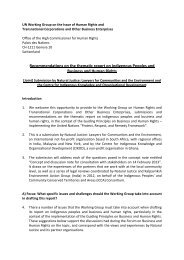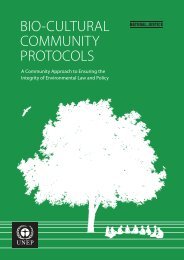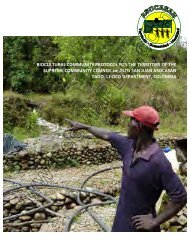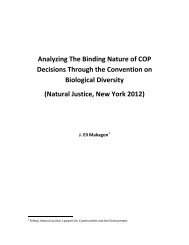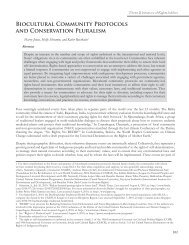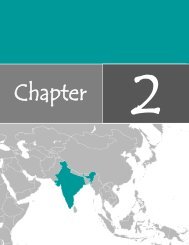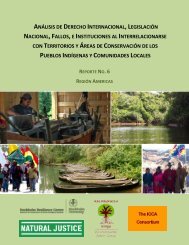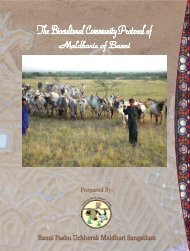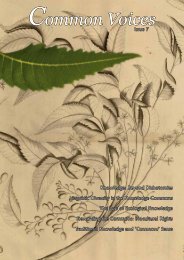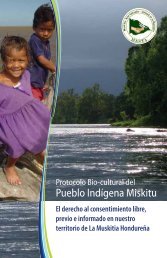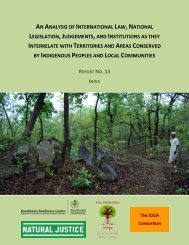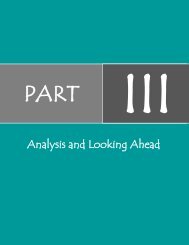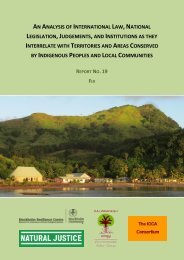English - Natural Justice
English - Natural Justice
English - Natural Justice
Create successful ePaper yourself
Turn your PDF publications into a flip-book with our unique Google optimized e-Paper software.
“First Nations have always practiced conservation. Our very existence asnations and peoples depends on the continued existence of the marineecosystems. We would not exist without the seas and aquatic resourcesthat were once bountiful on this coast. In your rush to protect some of thelast remaining areas on the coast, you must consider and respect ourplace in the environment. Many of you who espouse the virtues ofbiodiversity seem to overlook the place that our peoples and our cultureshave in the fabric of life. We have lived as part of these same areas orecosystems that you are now trying to protect since time immemorial.Therefore, you must also protect our place in those areas and ecosystems.Also, many of the areas being considered for protection represent someof our last opportunities to regain self-reliance. Protection of these areasis now necessary only because your cultures try to consume and developeverything that is in sight. Now that there is only a little bit left, youdecide to protect it. First Nations must not be made to suffer the burdenof conservation, when the system of overuse and over-harvest was not ofour making.”Ovide MercrediFormer National Chief of the Assembly of First NationsCanadian House of CommonsParliamentary Standing Committee on Canadian Heritage21 May 2001
Authored by: Harry Jonas, Ashish Kothari and Holly ShrummPublished by: <strong>Natural</strong> <strong>Justice</strong> in Bangalore and Kalpavriksh in Pune and DelhiDate: September 2012Cover Photos (clockwise, from top left): Sun setting on the remote village ofTovu, Totoya Island, Fiji. © Stacy JupiterA Dusun boy wearing a traditional rattan basket (wakid) as he helps gatherwild vegetables in the forests bordering the Crocker Range Park in Sabah.© Noah JacksonGuna boats (Panama). © Jorge AndreveKhwe community representatives from Namibia and Botswana participate ina workshop in the Bwabwata National Park, Namibia. © <strong>Natural</strong> <strong>Justice</strong>Contributors:The report draws directly on the work by the following people who wrote andcontributed to the national, regional and/or international reports: Ashish Kothari(Coordination of the Recognition Study), Harry Jonas and Holly Shrumm(Coordination of the Legal Review; International Law and Jurisprudence; AsiaRegional); Colleen Corrigan and Aurélie Neumann (Recognition); Eli Makagon andStephanie Booker (International Law and Jurisprudence); Fred Nelson (AfricaRegional and Kenya*); Brian T. B. Jones (Namibia*); Ndiawar Dieng and SoulèyeNdiaye (Senegal*); Simone Lovera (Americas Regional); Alcides Vadillo P. andCarmen E. Miranda L. (Bolivia*); Peigi Wilson, Larry McDermott, Natalie Johnston,and Meagan Hamilton (Canada Legal); Thora Herrmann, François Depey, MonicaMulrennan, Michael A. D. Ferguson, Gleb Raygorodetsky, and Catie Burlando(Canada Recognition); José Aylwin and Lorena Arce (Chile*); Patricia MadrigalCordero and Vivienne Solís Rivera (Costa Rica Recognition); Onel Masardule(Panama*); Staff at VIDS (Suriname*); Neema Pathak Broome (India*), ShaliniBhutani, Ramya Rajagopalan, Shiba Desor, and Mridula Vijairaghavan (India Legal);Tushar Dash (India Recognition); Taghi Farvar (Iran*), Puya Hariri, and MinaEsteqamat (Iran Legal); Nahid Naghizadeh and Abbas Didari (Iran Recognition);Justine Vaz (Malaysia Legal); Samson B. Pedragosa (the Philippines*); Dau-Jye Lu,Taiban Sasala and Chih-Liang Chao (Taiwan Legal); Dermot Smyth (Australia*),Chrissy Grant (Australia Recognition), and Hanna Jaireth (Australia Legal); StacyJupiter (Fiji*), Kiji Vukikomoala, Elizabeth Erasito, and Kevin Chand (Fiji Legal);Hugh Govan and James Comley (Fiji Recognition); Iris Beneš (Croatia Recognition);Marco Bassi (Italy Recognition); Sergio Couto (Spain Recognition); Andrey Laletin(Russia Recognition); and Helen Newing (United Kingdom Recognition).* Denotes both the Legal Review and Recognition Study
CONTENTSEXECUTIVE SUMMARY1. THREATS TO ICCAs2. INCREASED RECOGNITION AND SUPPORT2.1 Legal Recognition2.2 Non-legal Recognition and Support3. LAWS AND STATE INSTITUTIONS CONTINUE TO UNDERMINE ICCAs3.1 International Law is Exclusionary and Fragmented3.2 The Development, Implementation and Enforcement of Laws is Discriminatory3.3 Inappropriate Legislation Undermines ICCAs3.4 Non-legal Recognition and Support of ICCAs Remains Absent, Weak, orInappropriate4. RESILIENT COMMUNITIES, HEALTHY ICCAs5. KEY RECOMMENDATIONS: RECOGNIZE AND RESPECT INDIGENOUS PEOPLES’ ANDLOCAL COMMUNITIES’ RIGHTS TO PROTECT THE INTEGRITY OF THEIR ICCAs5.1 International Level5.2 National Level5.3 Recommendations for Non-legal Recognition and Support by Governments,Intergovernmental and Non-governmental Organizations, Research Institutions, andDonors
EXECUTIVE SUMMARYOverviewAcross the world, areas with high or important biodiversity are often located withinIndigenous peoples’ and local communities’ conserved territories and areas (ICCAs).Traditional and contemporary systems of stewardship embedded within cultural practicesenable the conservation, restoration and connectivity of ecosystems, habitats, and specificspecies in accordance with indigenous and local worldviews. In spite of the benefits ICCAshave for maintaining the integrity of ecosystems, cultures and human wellbeing, they areunder increasing threat. These threats are compounded because very few states adequatelyand appropriately value, support or recognize ICCAs and the crucial contribution made byIndigenous peoples and local communities to their stewardship, governance andmaintenance.In this context, the ICCA Consortium conducted two studies from 2011-2012. The first (theLegal Review) analyses the interaction between ICCAs and international and national laws,judgements, and institutional frameworks. The second (the Recognition Study) considersvarious legal, administrative, social, and other ways of recognizing and supporting ICCAs.Both also explored the ways in which Indigenous peoples and local communities are workingwithin international and national legal frameworks to secure their rights and maintain theresilience of their ICCAs. The box below sets out the full body of work from which this reportis drawn.1. Legal Review An analysis of international law and jurisprudence relevant to ICCAs Regional overviews and 15 country level reports:o Africa: Kenya, Namibia and Senegalo Americas: Bolivia, Canada, Chile, Panama, and Surinameo Asia: India, Iran, Malaysia, the Philippines, and Taiwano Pacific: Australia and Fiji2. Recognition Study An analysis of the legal and non-legal forms of recognizing and supporting ICCAs 19 country level reports:o Africa: Kenya, Namibia and Senegalo Americas: Bolivia, Canada, Chile, Costa Rica, Panama, and Surinameo Asia: India, Iran, the Philippines, and Russiao Europe: Croatia, Italy, Spain, and United Kingdom (England)o Pacific: Australia and FijiThe Legal Review and Recognition Study, including the research methodology,international analysis, and regional and country reports, are available at:www.iccaconsortium.org.
Main RecommendationsTo recognize and respect Indigenous peoples’ and local communities’ rights to protect theintegrity of their ICCAs, the following recommendations are made to governments,intergovernmental and non-governmental organizations, research institutions, and donors:a. Recommendations for Overall Legal Reform at the National LevelRespect and uphold human (including collective or community) rights.Improve implementation of legislation by harmonizing laws and undertakinginstitutional reform.Improve access to justice and uphold the rule of law.Support legal empowerment and capacity building initiatives.b. Recommendations for Legislating for Integrated Socio-ecological Systemsand Implementing Laws in Conformity with Human Rights StandardsRecognize and respect customary and collective land rights.Reform environmental and natural resource laws to enhance rights and removedirect threats to ICCAs.Reform policies and laws to effectively protect and promote traditional knowledge,cultural heritage and customary practices.Ensure protected areas comply with international rights, principles and standards.c. Recommendations for Appropriately Respecting and Supporting ICCAsRespect the rights of Indigenous peoples and local communities to selfdetermination.Create an enabling environment for self-designation and self-definition of ICCAs.Recognize the full diversity of Indigenous peoples and local communities and respectthe social, cultural and spiritual values of ICCAs.Recognize customary laws and decision-making processes.d. Recommendations for Non-legal Recognition and SupportProvide appropriate administrative and programmatic recognition and supportthrough national and sub-national strategies and action plans, incentive schemes,programmes, and research and funding policies related to the environment,development, and social welfare.Undertake locally appropriate research about aspects such as the conservationbenefits and values of ICCAs, threats to ICCAs, and community-determined plansand priorities for maintaining the integrity of ICCAs.Increase public awareness and social recognition of Indigenous peoples’ and localcommunities’ rights and ICCAs.Institute easily accessible and transparent funding mechanisms.Provide opportunities for training and capacity-enhancement, including culturallysensitive inputs and facilitation.Facilitate access to culturally and ecologically appropriate facilities and services forwellbeing and welfare (for example, water, sanitation, health, education, andinfrastructure).
Support Indigenous peoples’ and local communities’ mobilization and advocacyefforts at all levels.Support the self-defined establishment, consolidation and/or registration ofIndigenous peoples’ and local communities’ federations, associations, networks, andother organizations;Facilitate opportunities for Indigenous peoples and local communities, both womenand men, to participate in and promote their rights and ICCA-related issues withinenvironmental, human rights and other networks.This report sets out the key findings of this body of research. Section 1 argues that theinadequacy of rights afforded to Indigenous peoples and local communities and theinsufficient levels of legal and non-legal recognition and support for ICCAs in many countriesactively undermine the integrity of ICCAs. Section 2 illustrates that there are many positivedevelopments at the international and national levels. Section 3 highlights that, despitethese developments, Indigenous peoples and local communities are still routinely deniedtheir rights and ICCAs remain largely under-recognized and under-supported by stateagencies and other key actors. Section 4 shows that many Indigenous peoples, localcommunities and their ICCAs are resilient to hostile legal systems, though may need supportto flourish. Section 5 proposes a number of important recommendations for the 193 stateParties to the Convention on Biological Diversity, among others, about how to improve thelegal and non-legal recognition of and support for ICCAs.Dusun women and children in Ulu Papar, Sabah, Malaysia. © <strong>Natural</strong> <strong>Justice</strong>
1. THREATS TO ICCAsThere are three major categories of external of threats to ICCAs and to the Indigenouspeoples and local communities who control these areas. The first consists of systemicpressures on the environment and biodiversity worldwide, including habitat loss,overexploitation of resources, pollution, invasive species, and climate change (as identifiedin Global Biodiversity Outlook 3). In general, these are driven either by the predominantmarket- or state-dominated economies’ unsustainable patterns of resource extraction,production and consumption. The mainstream economic and governmental systems alsopromote rapid urbanization, loss of traditional languages and knowledge systems,dependence on imported and mass-produced foods and material goods, accumulation ofcapital, and elite capture, often also building on or exacerbating traditional inequities ofclass, caste, ethnicity, and gender. Due to the inextricable links between Indigenous peoplesand local communities and the territories and resources upon which they depend, the lossof biological diversity is fueling the loss of cultural and linguistic diversity and intergenerationaltransmission of knowledge and practices. This in turn undermines social andcultural cohesion and sophisticated customary systems of caring for territories andresources.The second category consists of the direct pressures on Indigenous peoples and localcommunities and their territories and resources. This includes, on the one hand, threatsfrom industrial methods of extraction, production and development (for example, landconversion for large-scale livestock farms or monoculture plantations, infrastructure anddams, industrial fishing and logging, and large-scale mines) and, on the other hand, threatsfrom exclusionary environmental and conservation frameworks that undermine the rightsand livelihoods of Indigenous peoples and local communities.The third category of threats – the focus of this synthesis report – has the potential toexacerbate the first two categories. The research highlights the widespread lack of effectivelegal recognition of a range of Indigenous peoples’ and local communities’ inherent rights,including to self-determination and self-governance, customary laws and traditionalinstitutions, and customary rights to their territories, lands, waters, natural resources, andknowledge systems. They suffer continued marginalization from legislative and judicialsystems and decision-making processes at all levels, impacts of discriminatory andfragmented legal and institutional frameworks, and exclusion from (or negative impacts of)governmental and corporate programmes of so-called development, conservation, andwelfare. This is compounded by a corresponding lack of non-legal recognition of the aboverights. Even civil society programmes can have inadvertent negative impacts on Indigenouspeoples and local communities and their ICCAs. These factors actively undermine Indigenouspeoples’ and local communities’ abilities to respond to the first two categories of externalthreats. In this context, it is vital to ensure appropriate and adequate recognition ofIndigenous peoples’ and local communities’ rights to maintain the integrity of their ICCAs.
2. INCREASED RECOGNITION AND SUPPORT2.1 Legal RecognitionThe International Law and Jurisprudence Report illustrates the impressive extent ofprovisions in binding and non-binding international instruments that support, broadly put,the rights of Indigenous peoples and local communities over their territories, areas andresources. Notably, these rights are not limited to human rights instruments, but can befound across the full spectrum of international law and policy, including in the followingcategories: biodiversity and conservation, endangered species, agriculture, climate change,desertification, wetlands, cultural heritage and intellectual property, and sustainabledevelopment. It also details examples of judgements from regional and national courts thatsupport Indigenous peoples’ and local communities’ rights, including a growing body ofjurisprudence on aboriginal title. The research at the international level confirms the factthat Indigenous peoples and local communities are not merely stakeholders, but are rightsholderswho must be respected and recognized as the stewards of their territories, areasand natural resources.Similarly, at the national level, it is evident that there are a number of improvements in thisregard, four of which are set out here. First, stronger and well-organized Indigenous peoples’institutions, alliances and organizations are increasingly demanding and participating inrelevant policy-making and legislative processes. Second, an increasing number ofgovernment, development and environment agencies are applying human rights standardsin their engagements with Indigenous peoples and local communities, including byupholding substantive rights, respecting procedural rights such as to free, prior andinformed consent (FPIC), and recognizing traditional authorities and customary laws. Third,many countries are pursuing land restitution and reform programmes. These programmescan significantly contribute to Indigenous peoples’ and local communities’ rights over theirterritories and resources, provided these rights are fully taken into account and communitytenure is promoted.Positive DevelopmentsIndigenous Protected Areas (IPAs) emerged from the Australian Government’s 1992commitment to establish a system of protected areas that is comprehensive, adequate andrepresentative of all the terrestrial bioregions of Australia – the National Reserve System(NRS). IPAs are planned, voluntarily declared (or dedicated) as protected areas and managedby Indigenous peoples themselves. While IPAs are not government protected areas, the IPAProgram is an Australian Government initiative to support these activities and to formallyrecognize IPAs as part of the NRS. In recognition that many government protected areas hadalready been established on traditional estates without Indigenous peoples’ consent, the IPAprogram also includes funding to enable Indigenous peoples to negotiate enhancedengagement in the management of existing government-declared national parks and otherprotected areas.A major development in Kenya has been the new 2010 Constitution’s provisions for landreform, which are being further developed in a range of policy reforms and draft legislation.The constitution effectively replaces trust lands with a new land tenure category of‘community lands’, devolving trust lands – which comprise the majority of Kenya’s land area– from the district to the community level. If effectively implemented, this has the potentialto greatly strengthen the tenurial basis of ICCAs across Kenya, including both formally
constituted areas such as conservancies as well as traditionally protected areas such aspastoralist communities’ customary grazing reserves. Nevertheless, the ultimate impact willdepend on its implementation, which is inextricably linked to the country’s broader politicalstruggles.Samburu herder protecting his flock in northern Kenya. © <strong>Natural</strong> <strong>Justice</strong>Fourth, some new protected areas, wildlife, environmental, freshwater, and marine laws aremore inclusive of Indigenous peoples’ and local communities’ institutions and customaryresource use practices, providing greater and more appropriate rights in relation to natureconservation and management policies, as well as over wildlife and tourism benefits. Fifth,there are examples of better coordination among government agencies, leading to moreintegrated implementation of otherwise disparate laws and policies, for example, withregard to socio-economic rights, Indigenous peoples’ territories, and wildlife management.Indigenous Peoples’ Rights and Integrated Legal FrameworksBolivia has recognized Lands of Original Communities (TCOs, in Spanish) since 1994. In thenew constitution of 2009, this concept has been replaced by the broader concept “OriginalIndigenous Peasant Territories” (TIOCs, in Spanish). These entities represent a formalrecognition by the State of the autonomy of the relevant Indigenous peoples, and allowthem to manage their territories through their own governance structures. The conceptsrespect the Indigenous perspective on the concept of ‘territory’, which unites the aspect ofpolitical control, power and administration with the exercise of property rights over the landand the natural resources that can be found on the land. Notably, TCOs and TIOCs are notconservation areas in the strict sense. However, most TCOs include high biodiversity and areecologically stable and a significant degree of the ecosystem integrity is due to thetraditional interaction between Indigenous peoples and their territories. For that reason,fourteen areas have the double status of TCO and protected area.Namibia provides Africa’s leading example of a formalized, government-crafted process ofdevolving clearly delineated rights over wildlife to rural communities. Through CommunalConservancies, adopted in policy reforms shortly after Namibia became independent fromSouth Africa in 1990, local communities can apply for and receive broad user rights overwildlife and both commercial and subsistence uses. Since the first of these conservancieswere created in 1998, over 70 Communal Conservancies now cover nearly 15 millionhectares, which is more than 16% of the country’s total area and roughly the same amountof land contained in Namibia’s formal protected area system.
The adoption in September 2007 of the UN Declaration on the Rights of Indigenous Peoples(UNDRIP) represents a strong breakthrough in setting international standards for Indigenouspeoples’ rights. Since then, the UNDRIP has been taken into consideration by a number ofnational and regional courts’ judgments. Similarly, the growing number of ratifications ofILO Convention 169, in particular in Latin America, has positively impacted the applicationand benchmark value of this instrument in national and regional case law. Other humanrights treaties such as the Convention on the Elimination of all Kinds of DiscriminationAgainst Women have important implications for ICCAs as well.Additionally, there is a growing body of case law – through the Inter-American Court ofHuman Rights (IACHR), the African Court on Human and Peoples Rights, and national courts– that is supportive of a range of Indigenous peoples’ and local communities’ rights based ontheir connection to their territories and unique social, cultural and ecological systems. In therecent case of Sarayaku v. Ecuador (2012), for example, the IACHR ruled that Ecuador had,among other things, breached Sarayaku villagers’ rights to prior consultation, communalproperty and cultural identity by approving a project without their involvement (see theInternational Law and Jurisprudence Report). At the national level, courts in Australia,Botswana, Belize, Canada, and South Africa, among others, have been instrumental in themove towards recognition of Indigenous peoples’ territorial rights.Emerging JurisprudenceMayagna Awas Tingni v. Nicaragua (2001): The IACHR recognized the validity of possessionover land based in Indigenous custom as a foundation for property over these lands, evenwhen a title is lacking. It also underscored the need to recognize and understand the broadrelationship between Indigenous peoples and their lands, which forms a fundamental basisfor their cultures, spiritual life, integrity, and economic survival.Saramaka v. Suriname (2006): Based on the communities’ relationships with their lands andnatural resources, the IACHR ordered Suriname to, among other things: delimit, demarcate,and grant collective title over the territory of the members of the Saramaka people inaccordance with their customary laws; abstain from acts until delimitation, demarcation,and titling has been completed, unless the State obtains the free, informed and priorconsent of the Saramaka people; review existing concessions; grant legal recognition of thecollective juridical capacity of the Saramaka people in accordance with their communalsystem, customary laws, and traditions; and adopt legislative, administrative, and othermeasures as may be required to recognize, protect, guarantee, and give legal effect to theright of the members of the Saramaka people to hold collective title of the territory theyhave traditionally used and occupied.These two judgements, among others, have helped establish the jurisprudence on the rightsof Indigenous peoples and are of utmost importance not just for Indigenous and tribalpeoples of Suriname and of other countries that have accepted the jurisdiction of the Inter-American Court, but also for other Indigenous peoples around the world.
2.2 Non-legal Recognition and SupportAt both international and national levels, ICCAs are also receiving much greater non-legalrecognition and support than ever before, six general forms of which are set out below.Administrative and programmatic recognition: ICCAs are provided space in governmentalprogrammes or schemes, with or without specific legal measures to do so. This includes, forexample, recognition in National Biodiversity Strategy and Action Plans and in nationalpoverty reduction programmes, sub-national programmes and schemes of a similar nature.In Iran, government organizationssuch as the Department of theEnvironment (DOE) and the Forests,Rangelands and WatershedOrganization are members of theNational Steering Committee of theUNDP-Global Environment FacilitySmall Grants Programme (GEF-SGP)and have lent their support andapproval to relevant GEF-SGPprojects focusing on ICCAs. In July2007, the director general of theDOE stated that: “The DOE isresponsible for adding 200,000hectares to the country’s protectedareas before 2020. We should uselessons learned from the pilotprojects in support of ICCAs in IranThe biodiversity-rich rangelands of the Qashqai tribal territory.© Samira Farahani, CENESTAand see how they can facilitate the process for more support and recognition of the ICCAs byapproving suitable policies and laws in this regard.”Financial, technical, and developmental support: Indigenous peoples or local communitiesreceive funding, inputs for building capacity, locally appropriate developmental facilities,facilitation for mapping, or other related activities. This could be provided by eithergovernment or non-governmental actors and includes specific schemes to support ICCAs inseveral countries and through global initiatives such as GEF-SGP.In the Philippines, financial support to the government has enabled the provision oftechnical assistance to Indigenous peoples in the formulation of their Ancestral DomainSustainable Development and Protection Plans (ADSDPP). The support that Indigenouspeoples receive in the delineation of their ancestral domains and the formulation of theirADSDPPs based on their traditions and culture effectively supports their initiatives for ICCAgovernance and management. The Philippine government also launched the NewConservation Areas in the Philippines Project (NewCAPP) “to expand and strengthen theterrestrial protected area system in the Philippines by developing new protected areasmodels … and expand the […] system with the integration of new conservation areas toinclude sites with a comprehensive ecological coverage and strong links to localcommunities and indigenous lands in the surrounding landscape.” NewCAPP is providingdirect funding for ICCA initiatives and related activities.
Documentation, research and database support: Various aspects of ICCAs are studied andreported on and ICCAs form part of one or more databases. Government, civil society,scientific institutions, and others, including the facilitation of initiatives by peoples orcommunities themselves, could undertake such activities. At the global level, the UNEPWorld Conservation Monitoring Centre has initiated an ICCA Registry (www.iccaregistry.org).The recognition study highlights a number of countries that have databases relevant toICCAs, including: Kenya, Namibia, Bolivia, the Philippines, Fiji, England, Spain, Canada, andIndia.Social recognition and support: Indigenous peoples and local communities are grantedawards, have access to media coverage and platforms to tell their stories, and so on. Thesecould be granted by government, civil society, or others. A number of internationalinstitutions also provide such recognition, notably the Equator Initiative.In Spain, the Mancomún de la Costa de Fuerteventura is a traditional local pastoralgovernance institution devoted to the regulation of extensive goat livestock breeding onFuerteventura (one of the Canary Islands) – a sustainable activity that supports the lastpopulation of the endemic Egyptian Vulture subspecies in the world. It was awarded theMedalla de Oro de Canarias 2011 (Canary Islands Golden Medal Award) from the regionalgovernment. Other countries that provide social recognition and support include India andthe Philippines.Networking support: Relevant peoples and communities are facilitated to (or themselvesinitiate ways to) exchange information and ideas with others, join or establish largerfederations or associations, and synergize with others in various other ways. While much ofthis is led by civil society and by peoples or communities themselves, governments havefacilitated this in some countries as well.In Australia, the IPA Program convenes annual national or regional IPA Managers Meetingsto enable managers and others associated with planning and managing IPAs to exchangeexperiences, ideas and concerns. These events have been essential to nurturing thedevelopment of the concept and practice of IPAs over the last 15 years. Other opportunitiesfor knowledge-sharing among Indigenous peoples involved in environmental managementare the bi-annual National Land and Sea Management Conference, largely funded by theAustralian Government, and regional Indigenous ranger conferences and workshops hostedby a diversity of Indigenous organizations from time to time.Advocacy support: Civil society undertakes lobbying, direct actions and other methods toinfluence government policy and programmes, or facilitates such action by peoples orcommunities themselves.Many of these forms of recognition and support intersect with each other and areinterrelated with legal recognition. For instance, in many countries, social recognition,networking and advocacy have been crucial in achieving legal and policy recognition of ICCAs.
3. LAWS AND STATE INSTITUTIONS CONTINUETO UNDERMINE ICCAsDespite greater respect for Indigenous peoples’ and local communities’ rights andrecognition and support for their territories and areas in select legal frameworks, therecontinue to be significant gaps and weaknesses of various kinds in most countries.3.1 International Law is Exclusionary and FragmentedNotwithstanding the advances in international law noted above, the rights gains have beenachieved in many cases against determined counterforces. Indigenous peoples and localcommunities struggle to be fully involved in the meetings, as evidenced in the recentmeetings of the World Intellectual Property Organization’s Intergovernmental Committee onIntellectual Property and Genetic Resources, Traditional Knowledge and Folklore. Wherethey are involved, certain state Parties continue try to avoid fully recognizing UNDRIP andother human rights.While there is clearly a large range of rights at the international level, they remaindisconnected from one another. The International Law and Jurisprudence Report highlights a‘body of law’, but in fact, the instruments and provisions lack any cohesion or integration.This also leads to Indigenous peoples and local communities having to negotiate for hardwonrights on a particular issue within one instrument or mechanism again in other fora.3.2 The Development, Implementation andEnforcement of Laws is DiscriminatoryProcesses through which laws are developed, implemented and enforced, in addition to thesubstantive provisions themselves, discriminate structurally and consistently againstIndigenous peoples and local communities in a number of ways. First, Indigenous peoplesand local communities are seldom meaningfully involved in the drafting of legislation thatwill impact important aspects of their ways of life. Second, laws that do support the rights ofIndigenous peoples and local communities on paper can be severely undermined wherestate agencies either inadequately implement them or implement them in ways that defeatthe laws’ original intent (willfully or by neglect).Implementation GapThe Chilean Fishing and Aquaculture Law of 1991 includes a provision to establish reservesfor artisanal fishing. Its insufficiency to protect Indigenous peoples’ traditional use of coastalareas motivated the Lafkenche Mapuche to undertake a campaign for the recognition oftheir rights over those areas, which resulted in the approval of a law on “Marine and CoastalSpaces of Aboriginal Peoples” (Ley No. 20.249). This law was adopted in 2008 and formallyrecognizes Indigenous peoples’ customary uses of coastal areas, including the foreshore andseabed, not only for artisanal fishing but also for cultural practices. It has raised manyexpectations, but until now, only one such reserve has been declared.
communities in national decision-making processes is extremely limited. Of the mechanismsthat do exist, many fail to ensure genuine and meaningful processes of participation,including in particular of Indigenous women. Moreover, legitimate struggles of Indigenousand local leaders against the destruction of their territories, resources and cultures areroutinely criminalized and faced with threats of militarization, extra-judicial killings,kidnappings and detentions. The denial of Indigenous peoples’ and local communities’substantive and procedural human rights – through states’ actions and inactions, often incooperation with corporations or organizations driving the interventions – fuels conflict,degrades ecosystems, and significantly undermines community cohesion.Human Rights ViolationsAs many other countries in theregion, Chile has ratified mostinternational human rights treaties,including ILO Convention 169, and ithas signed the UN Declaration onthe Rights of Indigenous Peoples.However, it has ignored the mostimportant principles of theseinstruments and failed to elaborateor adapt its legislation to ensurecoherence. Exploitation of naturalKawésqar, Puerto Edén, Aysén, Chile. © Lorena Arceresources and the establishment ofprotected areas on Indigenouspeoples’ territories take placewithout FPIC. In northern Chile, mining is imposed on lands and territories ancestrally ownedby Andean peoples. In the South, Eucalyptus mono-crops have devastated native foreststraditionally conserved by the Mapuche. The participation of representatives of Indigenouspeoples and local communities in decision-making processes is extremely limited.As in other continents, struggles over ICCAs often constitute some of the more prominenthuman rights conflicts taking place in African countries. One example is the conflict overpastoralist land rights (to land that has been managed as a customary grazing reserve,effectively constituting an ICCA) in relation to government protected areas management anda foreign hunting concession located in Loliondo, northern Tanzania. This conflict hasexisted since the early 1990s, but intensified in 2009 when at least 300 Maasai householdswere evicted from their own village land and a range of other alleged abuses and propertylosses took place. The root of the conflict is the government desire to control and lease outthe communities’ lands, which border Serengeti National Park and are home to abundantwildlife and outstanding scenery, ideal for tourism or in this case, high-paying recreationalhunting activities.b. Judicial Systems are Often a Barrier to <strong>Justice</strong>A growing body of jurisprudence emerging from regional, national and sub-national courtssupports the rights of Indigenous peoples and local communities, even when formalrecognition under state law is lacking. This illustrates a concerted effort by certain judgesand courts to understand and recognize the broad relationship between Indigenous peoplesand local communities and their territories, which forms a fundamental basis for theircultures, spiritual life, economic survival, and the ecological integrity of their ICCAs.
Despite this, however, national and sub-national judicial systems are inherently challengingfor Indigenous peoples and local communities. First, many cannot show standing before thelaw, negating the opportunity to defend their collective rights and interests in court. Second,the length of time that court cases take and their associated costs (including financial costsof lawyers as well as costs for time away from daily activities, travel from rural areas,communication with legal advisors, and so on) can be significant deterrents, especially whengoing against parties with seemingly limitless funds and political clout to challenge adversedecisions. Third, even when communities win cases, enforcing the judgements can beextremely challenging. Beyond these common issues, some countries suffer fromparticularly acute disrespect for the rule of law and corruption, which further undermine theintegrity and effectiveness of the judicial system.Lack of StandingIn Suriname, for example, twelve members of the Indigenous community PK filed acomplaint in 2003 against the State Suriname and a mining company S., regarding gravelmining in the ancestral territory of the community causing harm to the communitymembers’ livelihood (Community members versus the State Suriname and mining companyS). The decision of the judge was to deny the plaintiffs’ claim as well as the company’scounterclaim, partly because the community members did not – in the court’s view – havethe status to claim the measures requested.c. Many Communities and Supporting Civil Society OrganizationsLack Knowledge of Legislative and Judicial SystemsMany Indigenous peoples and local communities and their supporters lack the awarenessand capacity to make full use of their rights and the associated legislative and judicialsystems. Some countries even lack a cadre of lawyers able to take on such cases. Conversely,governmental and private interests can be very effective at using the law to further theirown interests, often at the expense of peoples and communities.Unused RightsIn India, for instance, the Forest RightsAct has seen very inadequate use bycommunities to claim rights to andgovernance of forests. There areseveral reasons for this, including lackof awareness about the Act or how tomake claims; lack of proactiveassistance from governmentdepartments; deliberate obstruction bysome government agencies or officials;difficulties in finding evidence to filewith the claims; and superimposition oftop-down boundaries related togovernment schemes rather thanacceptance of customary boundaries ofthe community.Members of the federation of community conserved areas inNayagarh district, Orissa (India), meeting to discuss the 2006Forest Rights Act. © Neema Pathak Broome
3.3 Inappropriate Legislation Undermines ICCAsAcross jurisdictions, similar types of laws (or lack thereof) are often framed in ways that arebiased against Indigenous peoples and local communities, further hindering their ability toretain the integrity of their ICCAs.a. Lack of Recognition of Customary Laws and TraditionalAuthorities, Institutions and Decision-making ProcessesUndermines Community CohesionClosely linked to human rights, many countries do not recognize or respect Indigenouspeoples’ and local communities’ customary laws and traditional authorities, institutions anddecision-making processes. Where these are not recognized, culturally embedded systemsof caring for territories and resources and engaging with others are undermined, oftenleading to deterioration of traditional languages and sophisticated systems of knowledgeand practice. Notably, the multifaceted role of women in ICCAs is often overlooked. Instead,peoples and communities are required to establish institutions that accord with thedominant national paradigm in order for their authorities to be recognized asrepresentatives. This violates a number of international human rights instruments and canlead to outsiders ‘consulting’ with and obtaining the agreement of imposed structuresinstead of the legitimate traditional authorities, which further undermines communitycohesion and internal capacity to respond effectively to external threats.Non-recognition of Community StructuresIn countries like Suriname and Chile, the official administrative systems only recognizepolitical representative structures, Western-style organizations and local governmentstructures that do not necessarily represent the opinions and aspirations of Indigenouspeoples and local communities. Often, as in Suriname, they are also affiliated with andinfluenced by political parties.b. Lack of Recognition of Customary Land Rights is a FundamentalIssueAlthough there have been a range of land tenure reforms worldwide to address historicalinjustices, many of these programmes have not placed sufficient emphasis on customarysystems of tenure, stewardship or trusteeship. This issue is particularly acute in Africa,where hundreds of millions of rural Africans do not have secure land rights. Additionally,women often lack formal rights to land tenure. Common property resources such as forestsand rangelands remain particularly vulnerable, usually considered unoccupied, unregisteredand thus available for allocation by the state to individuals or corporations. This situation is afundamental source of insecurity and actual or potential dispossession for up to half a billionpeople across Africa. Similar situations exist in many formerly colonized countries, such asthose in South Asia.Insecure land rights mean that Indigenous peoples and local communities are unable tolegally enforce their customary ownership, rules and control, particularly when thegovernment issues exploitative concessions and other permits in their territories. It also
hinders communities’ abilities to make long-term plans in accordance with their own visionsand aspirations, compounding legal uncertainty with further marginalization.Lack of RecognitionOne Indigenous person from Suriname summed up the sentiment roused by the lack ofrecognition, stating that: “It is as if we simply do not count and exist; the animals have morerights than us.”The surge in land acquisition globally, and particularly in sub-Saharan Africa because of theweakness of local land rights, is rapidly intensifying pressure on the traditional territories ofpastoralists, small-scale and subsistence farmers, hunter-gatherers, forest-dependentcommunities, and others in rural areas. The recognition of land rights, perhaps above allothers, will determine the opportunities for ICCAs to contribute effectively to conservationand rural livelihoods.Lack of Land TenureIn Cameroon, as in many African countries, the state claims ownership over all unregistered(i.e. not formally titled) lands, including all lands claimed according to customary rights andheld through common property regimes. Thus, while local communities throughoutCameroon depend integrally on the forests in which they live, their customary rights are notrecognized or delineated by the law as real property interests. This situation extends to theentire forested landscape of the Congo Basin where statutory tenure regimes are almostuniformly centralized.In Namibia, the most significant threat to conservancies and community forests is the lack ofsecure and exclusive group land tenure to underpin the legal rights to the use andmanagement of natural resources. If communities cannot prevent other people from usingthe land they wish to set aside for wildlife and tourism, there remains little incentive tomaintain wild habitats. This issue is compounded by the fact that the government continuesto view communal land as state land, over which it can take decisions about how the land isused.In India, the government owns much of the lands within Indigenous peoples’ and localcommunities’ conserved territories and areas. Not only do they not have ownership rights,but they also have very limited or no recognized access rights. The government can decideto change the land-use or lease the land for any other purpose without consulting or eveninforming the conserving communities. This is beginning to change with new legislation onforest rights, though very slowly.c. No Rights Over Sub-soil ResourcesVery few countries provide Indigenous peoples any rights over their sub-soil resources; inthose that do, the rights are muted (such as in Bolivia and Canada). As previously discussed,where laws regulating access to natural resources (including sub-soil resources) areprejudicial to Indigenous peoples and local communities, laws that otherwise support theirrights to retain the integrity of their ICCAs are significantly disabled. This is particularlyevident in the context of laws relating to mining that are privileged by state agencies overthe rights of Indigenous peoples and local communities.
Resource RightsThe Constitution of the State ofPanama ignores the rights ofIndigenous peoples to their naturalresources. According to theConstitution, the State has nationalsovereignty over all naturalresources in the country.Subsequent laws stipulate thatsubsoil resources and forests are allproperty of the State, disregardingIndigenous peoples’ rights to thesame resources. This has triggeredmany conflicts and cases of loss ofnatural resources due to both legaland illegal exploitation.Guna boats, Panama. © Jorge AndreveThe Constitution of Suriname states in Article 41 that natural riches and resources are theproperty of the nation and that the nation has the inalienable right to take full possession ofthem for the economic and social development of Suriname. The Constitution does notacknowledge the existence or rights of Indigenous or tribal peoples in Suriname.All sub-soil resources, including petroleum, are the property of the Fijian State as providedby Section 3 of the Mining Act. The Director of Mineral Resources has broad powers to issueprospecting licenses over land areas without owner consent and to declare a site less than250 ha a mining site if it has importance to the nation, even if it is in a gazetted protectedarea. Section 11 provides a narrow class of lands exempt from any prospector’s rights ormining tenement, including Fijian villages, burial land and reserved forests, amongst others.d. Marginal Rights-based Approach to <strong>Natural</strong> Resources and theEnvironmentIn many cases, laws relating to natural resources and the environment make no specialprovision for Indigenous peoples or local communities. This effectively criminalizes theircustomary livelihoods and resource use practices. At the same time, the legal frameworkscreate sectoral approaches to agriculture, forests, fisheries, water, wildlife, and othernatural resources. This not only fragments otherwise interconnected ecosystems, but it alsotends to mandate their overexploitation for short-term economic gains. In this light, newand emerging financial and market-based incentive schemes, for example, access andbenefit sharing (ABS) and reducing emissions from deforestation and forest degradation(REDD), remain heavily contested. Indigenous peoples and local communities fear they willcause further marginalization, in addition to turning nature and natural resources purely intotradable commodities in the eyes of the state.<strong>Natural</strong> Resource ManagementIn Suriname, the Hunting Law 1954 (revised last in 1997), the Fish Protection Law 1965(revised last in 1981) and the Sea Fishing Law 1980 (revised last in 2001) similarly make noreference to Indigenous and tribal peoples, thus making their customary livelihood practices
illegal.In Senegal, the marine realm is excluded from the ambit of the 1996 decentralizationreforms, which has impeded local communities from gaining legal recognition of coastalICCAs. Nevertheless, some pioneering communities have been able to extend the acceptedpurview of the decentralization laws and were among the first in the country to have theirICCAs formally recognized. Foremost amongst these is Kawawana, in Casamance Province,which obtained the approval of the Provincial Governor and Regional Council as a coastalICCA. Despite this important local example, coastal ICCAs remain on questionable legalground and will require additional reforms to fisheries or to decentralization statutes toprovide coastal communities with clearer and more secure jurisdictional rights.e. Protected Areas Laws are Falling Behind International RightsThere have been important advances in international protected area law and policy over thepast 10 years, most notably, the Convention on Biological Diversity’s Programme of Work onProtected Areas (particularly Element 2 on governance, participation, equity, and benefitsharing). Some countries boast successful examples of shared governance and comanagementwith Indigenous peoples and local communities or of recognition of ICCAs.However, most governments are struggling to enshrine these international standards withinnational protected area laws and policies. Notwithstanding salutary examples, theestablishment, expansion, governance, and management of state and private protectedareas often conflict or overlap with the customary territories, areas and practices ofIndigenous peoples and local communities. Few countries’ protected area frameworksrecognize ICCAs or allow for devolution of governance to peoples or communities. In somethat do, there is often an inappropriate imposition of top-down designations, institutionalarrangements, or conservation requirements in order to fit them into existing stateprotected area frameworks. This undermines the diversity of ICCA arrangements and is asignificant risk to Indigenous peoples’ and local communities’ rights and ways of life.In formal protected areas that overlap with or subsume ICCAs, particularly those governedand managed by the state, Indigenous peoples and local communities generally bear adisproportionate amount of the costs and enjoy relatively few benefits other than menialemployment in tourism facilities or as guides or rangers. The establishment or expansion ofsuch protected areas is often a point of conflict with Indigenous peoples and localcommunities, particularly when the customary use of natural resources is prohibited andtraditional knowledge systems are ignored, including those of rural and Indigenous women.This atmosphere of legal uncertainty and often harsh enforcement of top-down rulesundermines customary systems of stewardship, governance and management. Thesubsequent deterioration of traditional knowledge and customary laws, coupled withpressures from growing populations and migrants, make these protected areas prone tounsustainable use of resources.Exclusionary ConservationEven in Panama, where Indigenous peoples’ territories have been recognized in the form ofComarcas, the law does not explicitly recognize or support the creation of communitygoverned protected areas. Indigenous peoples and local communities generally gain littledirect or immediate benefit from an area being declared protected, other than somepossible employment as guides or enforcement officers. In the majority of protected areas
the traditional use of natural resources isprohibited, which also has significantnegative impacts on the traditionalknowledge of the affected peoples. Thereare a number of ongoing disputes about thecreation of parks on ICCAs.Similarly, in Namibia, where provision hasbeen made for conservancies, neitherpolicies nor legislation recognize the landrights or basic human rights of people livingwithin state protected areas. There are nolegal provisions for involving people livingwithin or around the parks in planning,governance or management processes.Although many conservationists promote the strictprotection of major predators without the presence ofpeople, leopards and lions are also being conserved inICCAs in North Western Namibia. © Brian Jones3.4 Non-legal Recognition and Support of ICCAsRemains Absent, Weak, or InappropriateNotwithstanding a number of progressive measures in several countries that provide nonlegalrecognition and support to ICCAs, there remain significant gaps and weaknesses inmost countries.a. Administrative and Programmatic Recognition is Absent or WeakICCAs are often excluded from governmental programmes and schemes or figure only inmarginal terms, especially where they do not have legal recognition. Even national plans andprogrammes for biodiversity or wildlife conservation or sustainable use of biologicalresources often lack focus on ICCAs. Very seldom do poverty eradication or ruraldevelopment programmes consider ICCAs (or more generally the practices of Indigenouspeoples and local communities) as potentially effective ways of securing livelihoods,providing jobs, or in other ways achieving poverty- and development-related goals.b. Financial, Technical, and Developmental SupportLinked to the general lack of legal, administrative or programmatic recognition, manycountries do not have dedicated funds for or technical and developmental programmesoriented to the particular situations of Indigenous peoples and local communities or theirICCAs. Even where there are programmes for Indigenous peoples and local communities,they do not often support their own resource use and management traditions or institutions.Particularly weak is the provision of funding or technical support for activities such as legalempowerment, mapping and building capacity for reclaiming rights to and management oftraditional territories and areas. In several places where such support does exist, it can beinappropriate in imposing uniform and gender-insensitive institutional structures, overlyrestrictive rules and regulations, and conditions that end up undermining the autonomy anddiversity of local arrangements.
In Namibia, support to conservancies has been well-funded in the past, but as indicatedabove, donor support has been declining. One of the problems is that new conservancies arestill emerging and require support from NGOs and government to become operational.Meanwhile, the more mature conservancies are becoming more self-reliant. Conservanciesand community forests are technically able to raise their own funds from national andinternational sources, but this remains difficult because of their remoteness from the capital(Windhoek). Improved communications technology such as cellular telephones andincreasing internet connection in remote areas could change this situation.c. Documentation, Research and Database Support is InadequateMost countries have severely inadequate documentation of and research on ICCAs andalmost none have databases. This weakness is not only prevalent in government agencies,but also civil society; part of the reason is that until very recently, ICCAs have simply beeninvisible to the formal sector of scientists and conservationists. Another problem is that inmany places where such activity is increasing, the documentation, research or databasedevelopment is not by or with the Indigenous peoples and local communities themselves,does not include procedures like FPIC, and is conducted and presented in languages orformats not accessible to the peoples and communities. Finally, documentation cansometimes also lead to unwelcome attention or pressures on an ICCA, for example, byinstigating unsustainable tourism.d. Social Recognition and Support are Far From AdequateWhile public exposure to and understanding of ICCAs is rapidly rising in some countries, inmost it remains a somewhat unrecognized phenomenon. The media, for instance, stillfocuses much more on formal government-managed protected areas. Forums and platformswhere Indigenous peoples and local communities can tell their stories, through which socialrecognition could increase, are extremely limited.e. Networking and Advocacy Support Remain LimitedIn many countries, Indigenous peoples and local communities are struggling to set up theirown networks and advocacy platforms. Where such networks of civil society organizationsdo exist, they are often excluded or only marginally included from important socialprocesses. In multi-lingual or multi-cultural societies, for example, such marginalizationtakes the form of linguistic or ethnic exclusion.Although Chile has well-informed Indigenous peoples’ organizations and an aware civilsociety, lack of coordination between them and especially the lack of representativecommunity voices have hindered an integration of their views in the development of publicpolicies affecting them. An example is the minimal representation that they have had in arecent discussion of the merits of the Biodiversity and Protected Area Service (BPAS). Ananalysis of the impacts of the BPAS on ICCAs and proposals for proper ICCA recognition andsupport are virtually non-existent.
4. RESILIENT COMMUNITIES, HEALTHY ICCAsIn spite of the above challenges, communities have shown marked resilience to overcomediscriminatory legal, economic and social systems. There are a large number of examples ofthriving ICCAs in otherwise hostile legal environments. Similarly, where ICCAs have beendirectly threatened, Indigenous peoples and local communities are showing themselves tobe highly adept at resisting egregious threats and engaging state and non-state actors toachieve their aims. In sum, many ICCAs have survived largely as a result of the strong willand dedication of the Indigenous peoples and local communities who govern them (whetherde facto or de jure), rather than due to any legal or non-legal recognition by governments orother actors.Nonetheless, appropriate legal, administrative and social recognition – coupled withreduction of both structural and systemic barriers to their rights and of external threats totheir territories and resources – are indispensable conditions for Indigenous peoples andlocal communities to reclaim previously alienated ICCAs and maintain the integrity of theirICCAs for generations to come. Central to this is the recognition and appreciation of themultiple roles and benefits of ICCAs, which include realizing human rights, conserving andsustainably using biodiversity, eradicating poverty, securing livelihoods, food and watersovereignty, and mitigating and adapting to climate change, among others.Recommendations about how to do this are set out in the next section.The Inuit of Nunavut have a comprehensive agreement with the Government of Canada.Nunavut is the largest, northernmost, and newest territory of Canada, officially separatingfrom the Northwest Territories on 1 April, 1999 (via the Nunavut Act and the Nunavut LandClaims Agreement Act). Being the dominant population in Nunavut, the Inuit of Nunavuthave qualified opportunities to exercise customary law. For example, the Nunavutgovernment requires the application of Inuit knowledge (Qaujimajatuqangi) for thegovernance of the environment in the territory.(Left to right) Hunting party with dogsleds; caribou; igloo (traditional homestead). © Nunavut Wildlife Management Board
5. KEY RECOMMENDATIONS: RECOGNIZE ANDRESPECT INDIGENOUS PEOPLES’ AND LOCALCOMMUNITIES’ RIGHTS TO PROTECT THEINTEGRITY OF THEIR ICCAs5.1 International LevelParties to instruments dealing with human rights, Indigenous peoples and local communities,the environment and natural resources, cultural heritage, sustainable development, andhuman welfare (among others) should take responsibility for understanding and upholdingthe wealth of commitments and obligations enshrined in international law and regionaljurisprudence that support Indigenous peoples and local communities rights, including toretain the integrity of their ICCAs. Treaty secretariats, intergovernmental organizations,NGOs, and others should assist with raising awareness and building capacity to do so withinthe relevant governments.UN treaty monitoring bodies and secretariats, the UN Permanent Forum on IndigenousIssues, the UN Expert Mechanism on the Rights of Indigenous Peoples, and the UN SpecialRapporteurs on the Situation of Human Rights and Fundamental Freedoms of IndigenousPeoples, on Cultural Rights, on Minority Issues, and on the Right to Food, among others,should examine and promote recognition and respect for ICCAs as means to realize a rangeof human rights instruments.The Secretariat of the Convention on Biological Diversity should continue to facilitate theimplementation and monitoring of various decisions of the Conference of the Parties,programmes of work, and cross-cutting themes related to ICCAs, including through trainingprogrammes and capacity building workshops, dissemination of information, andencouraging Parties to take up the recommendations of this study in their NationalBiodiversity Strategies and Action Plans and national reports. The Secretariat should alsoencourage appropriate recognition of ICCAs in all other relevant international treaties andmechanisms and regional fora in which it has informal or formal status.The FAO is called upon to integrate support for ICCAs in ongoing programmes for landreform, agricultural extension and community forest and fisheries management. Its supportfor the rights of farmers, livestock keepers and small-scale and artisanal fishers is also crucial.The UNDP-GEF Small Grants Programme is congratulated for including ICCAs in its 5 thOperational Phase Biodiversity Portfolio. Building on this positive development, other UNagencies, in particular those with a mandate related to land and environmental matters, arecalled on to fully integrate appropriate support programmes for ICCAs into their work andfunding mechanisms.The International Union for Conservation of Nature (IUCN) should facilitate awareness andappreciation of ICCAs through its volunteer Commissions, regional offices, and globalprogrammes, including by diffusing information about related policies, agreements,resolutions, and recommendations, and providing technical assistance to its members andpartners to develop appropriate legal and policy measures to recognize ICCAs incollaboration with Indigenous peoples and local communities.
Conservation and environmental organizations (including NGOs, policy and researchinstitutes, parastatal agencies, intergovernmental organizations, and networks, amongothers) must fully respect and uphold international human rights and embrace newparadigms of governance diversity and good governance, including a greater focus onIndigenous peoples’ and local communities’ rights and their ICCAs and genderconsiderations. Similarly, human rights and development organizations should mainstreamthe environment into their approaches and programmes as a fundamental aspect ofsecuring human rights.5.2 National LevelThe most important recommendations of this report are for governments to recognize andensure the effective recognition and enforcement of Indigenous peoples’ and localcommunities’ rights, including their rights to territories and resources, to self-governmentthrough their own traditional governance structures, and to provide or deny FPIC for anyprojects or activities that might affect them or their territories. It is also critical to supportingIndigenous peoples and local communities, both women and men therein, to engage in thedevelopment and implementation of laws and to increase effective access to justice.Governments are called on to legislate for socio-ecological systems and implement laws inan integrated and mutually supportive manner.a. Recommendations for Overall Legal Reform at the National LevelA number of overall legal reforms and systemic changes are required to secure the rights ofIndigenous peoples and local communities, including in relation to their ICCAs. Respect and Uphold Human RightsThere is a strong correlation between supportive provisions for human rights and Indigenouspeoples’ rights on the one hand and good governance and management of lands, territoriesand natural resources on the other. In this context, the foundation for any recognition ofICCAs is law and policy that recognize self-determination, self-governance, and ownership orcustodianship rights of Indigenous peoples over their traditional territories or other lands orwaters, including natural resources and cultural systems. It is also critically important toextend similar international standards afforded to Indigenous peoples to tribal and localcommunities who can also show a deep cultural connection to their territories, areas andnatural resources therein.Accordingly, states should ratify and ensure effective compliance with international humanrights instruments, recognizing and formalizing the rights of Indigenous peoples and localcommunities and major groups like women in accordance with international standards andobligations. States should also ensure transparency and accountability in all matters relatingto Indigenous peoples’ and local communities’ rights, including allowing UN SpecialRapporteurs and other international investigation and monitoring mechanisms to enter theircountries, and ensure the rights to freedom of speech, assembly, information, andindependent media.In many cases, this will necessitate constitutional reform to create a more enabling legalframework for Indigenous peoples’ and local communities’ rights and their ICCAs. Thisrequires higher-order transformation of power relations, governing structures, and citizens’rights.
Human Rights and Constitutional ReformKenya’s new (2010) Constitution abolishes Trust Lands and replaces them with CommunityLands as a new tenure category, which has the potential to be one of the most importantreforms for community natural resource governance that has taken place in the region inrecent years.In 1991, Bolivia ratified ILO Convention 169, and the Constitutional Reform of 1994recognized the existence of Indigenous peoples and their right to Original Communal Lands(TCOs, in Spanish). Article 2 of the new Constitution (2009) states: “Considering the precolonialexistence of nations and original Indigenous peasant peoples and their ancestraldominance over their territories, the free determination within the framework of the unity ofthe State is guaranteed, which consists of their right to autonomy, self-government, theirculture, the recognition of their institutions and the consolidation of their territorial entities,in accordance with this Constitution and the Law”. In Article 30, the right to collective titleover lands and territories of Indigenous peoples is recognized, which is further elaborated inArticle 403. Indigenous peoples exercise a right to property and exclusive access, use andexploitation rights over renewable natural resources on their territories. Regarding nonrenewableresources and sub-soil resources like fossil fuels, only a right to prior andinformed consult and a share of the benefits of the exploitation is granted.However, the Bolivian Governmenthas combined the discourse ofdefending the rights of Mother Earthand the need for a ‘buen vivir’ (goodlife) in harmony with nature with anaggressive economic policy thatprioritizes the exploitation of fossilfuels, minerals and other naturalresources. The promotion of megaprojectswithin the framework of theregional infrastructure initiative ofSouth America (IIRSA, in Spanish),mines, biofuel production, soyexpansion, and hydro-electric damshas been accompanied by increasingThe IX Indigenous peoples’ march against the construction ofthe road through the TIPNIS, in their rise to the Andes (Bolivia).© www.ftierra.orgporosity of environmental regulations and a large number of social conflicts. The well-knownconflict over the proposed road through the TIPNIS (Isiboro Sécure National Park andIndigenous Territory) is but one example. Improve Implementation by Harmonizing Laws and UndertakingInstitutional ReformLaws require effective implementation to achieve their stated aims. Yet it is clear from theresearch that even in instances where there are laws that support human rights and ICCAs,they are often inappropriate, top-down, hindered by administrative barriers, uniformly orineffectively implemented, or overridden by laws and policies that contravene theirprovisions. Even in lieu of any new laws, significant improvement in many countries could beachieved through legal and institutional reform. This would involve rationalizing andharmonizing the full range of relevant laws as a cohesive framework, eradicating conflicts
etween laws and implementing agencies (such as between environmental and economicdevelopment), and ensuring that they are implemented in an integrated manner.Legal and Institutional IntegrationUnder the current Fijian Fisheries Act, protected areas where fishing is strictly prohibitedcannot be established legally, as all Fijians are permitted to fish for subsistence use withcertain gear. This gap in the law has led to difficulties related to community enforcement ofboth customary and national fisheries laws.Improve Access to <strong>Justice</strong> and Uphold the Rule of LawAs noted above, there are an increasing number of judgements being handed down byregional and national courts that are supportive of Indigenous peoples’ and localcommunities’ rights. Yet these cases remain isolated examples against a backdrop of courtsanctionedinjustice. Courts should not be the bastions of the privileged and must remainindependent. A review and revision of how Indigenous peoples and local communities canchallenge legislation and administrative actions and bring violations of laws that affect themto court is urgently required. The issue of legal standing is central to improving matters, as isthe accessibility of legal empowerment and free legal aid. Upholding the rule of law at alllevels is also fundamental to a functioning legal system that protects the rights of its citizens,rather than one that further entrenches the confluence between business and the state.Aboriginal TitleAboriginal title (also referred to in various countries as Indigenous title, native title, originalIndian title, or customary title) is a common law doctrine that the land rights of Indigenouspeoples to customary tenure persist after colonial powers assumed sovereignty. Therequirements of proof for the recognition, content and methods of extinguishing aboriginaltitle, as well as the availability of compensation in the case of extinguishment, varysignificantly by jurisdiction. A number of important judgements have been handed down bynational courts in Commonwealth countries affirming aboriginal title, including Botswana(San-Central Kalahari Game Reserve Cases), South Africa (Richtersveld Community v. AlexorLimited), Belize (Cal v. Attorney General), Canada (Delgamuukw v. British Columbia), andAustralia (Mabo v. Queensland (No. 2)).Support Legal Empowerment and Capacity BuildingLawyers, judges, legal aid clinics, NGOs, and donors should support Indigenous peoples andlocal communities to learn about and engage effectively with state legal systems. A series oflegal empowerment and capacity building programmes, including research, development ofeducational resources and tools, translation services, and financial support, should bedeveloped in close collaboration with diverse peoples and communities.
. Recommendations for Legislating for Integrated Socio-ecologicalSystems and Implementing Laws in Conformity with HumanRights StandardsThe effect that legal and institutional fragmentation has had on otherwise interconnectedsystems cannot be overstated. What is required is a shift from a disaggregated anddiscriminatory approach to the law to one that supports Indigenous peoples and localcommunities and the ecosystems and broader territories and areas upon which theydepend. Governments should legislate for dynamic landscapes, seascapes and humanenvironmentsystems, not for their constituent components as distinct entities. This needsto be augmented by the integrated implementation of laws in conformity with human rightsstandards alongside localized, bottom-up efforts.Recognize and Respect Customary and Collective Land and Resource RightsThe research strongly underscores the critical importance of legal recognition of Indigenouspeoples’ and local communities’ (including women therein) customary and collective landand resource rights to maintaining the integrity of their ICCAs. Yet, many Indigenous peoplesand local communities have only de facto rights to their territories and resources, not formallegal rights recognized by the state. Accordingly, land tenure systems that recognize andrespect customary and collective land and resource rights are urgently required. Notably,any land tenure reforms must accord with the local populations’ customs (while requiringlegitimate equity considerations), especially providing for collective or communal tenurewithout imposed restrictions or requirements for ‘development’ or other uses. Such reformsshould also include simpler procedures with lower costs and fewer bureaucratic barriers torealizing those rights.Customary and Collective RightsIn terms of current legislation, the Fijian i Taukei Lands Act provides in Section 3 that ‘nativelands shall be held by native Fijians according to native custom as evidenced by usage andtradition.’ This provision allows for a broad spectrum of usage and governance rights definedby native custom andtradition, as well as beingsubject to the regulationsmade by the iTaukei AffairsBoard. Section 21 of theForest Decree gives provisionfor the customary rights ofnative Fijians on native landand the right to exercise anyrights established by nativecustom such as hunting,fishing or collecting wildfruits and vegetables.According to Section 13 ofthe Fisheries Act, it is anoffence to fish or collectshellfish without a permit for A ridge-to-reef seascape from Waya Island, Fiji. © Stacy Jupitertrade or sale in an area
where the fishing rights or qoliqoli (traditional fishing grounds) of a mataqali (clan) arerecognized in the Register of i Taukei Customary Fishing Rights; members of the mataqalithemselves are excepted. This allows for the involvement of communities in the governanceof the coastal zones and the application of customary laws to regulate the i qoliqoli in someinstances. Notably, by 2011, there were over 149 Locally Managed Marine Areas (LMMAs)managed by 400 communities, covering half the area of Fiji’s qoliqoli.Reform Environmental and <strong>Natural</strong> Resource Laws to Enhance Rights andRemove Direct Threats to ICCAsFirst, states should ensure the full and effective participation of Indigenous peoples and localcommunities, including women, in all decision-making processes related to the environmentand natural resources. Second, states should reform environmental and natural resourcelaws to fully comply with international human rights instruments and customary laws oftraditional authorities. Third, states should remove subsidies and perverse incentives forlarge-scale, industrial methods of extraction, production and development that threatenICCAs directly or indirectly. Fourth, states should review existing concessions and withholdthe issuance of new titles or licenses that may conflict or overlap with ICCAs withouteffective realization of the right to FPIC and other international and customary rights andprocedures of the affected peoples or communities.Integrated Socio-ecological SystemsNamibia’s Communal Conservanciesare based on the Policy on WildlifeManagement, Utilisation andTourism in Communal Areas (1995)and the subsequently enactedNature Conservation AmendmentAct (1996). The Act provides forrural communities to formconservancies and gain use rightsover wildlife and tourism within theconservancies.Article 96 of Panama’s Wildlife Law(1998) states that the NationalEnvironmental Authority willcoordinate all matters related to theenvironmental and naturalresources in Indigenous peoples’territories with the traditionalCommunity game guards download GPS data during the annualgame count in the Mayuni Conservancy, North Eastern Namibia.© Olga Jonesauthorities of the relevant peoples and communities. The law also stipulates in Article 104that when authorizing the use of natural resources in Comarcas or the lands of Indigenouspeoples, projects presented by the members of the community will be preferred, providedthey meet the conditions and procedures established by the competent authorities.
Reform Policies and Laws to Effectively Protect and Promote TraditionalKnowledge, Cultural Heritage and Customary PracticesThe research shows that states should work with Indigenous peoples and local communitiesto develop culturally appropriate legal regimes that protect their collective rights overtraditional knowledge and cultural heritage, taking into account the specific knowledge andheritage of women. This may include supporting the appropriate documentation, valuationand revitalization of traditional knowledge, languages and customary practices.States should also enact the principle of subsidiarity by decentralizing rights over territoriesand resources to the Indigenous peoples and local communities concerned. Towards thisend, states should consider an overall law or policy on community stewardship of naturalresources that recognizes traditional authorities and customary laws and practices andpromotes integrated ecosystem approaches to governance and management.Ensure Protected Areas Comply with International Rights, Principles andStandardsStates should undertake a full review of national protected area systems with Indigenouspeoples and local communities, NGOs, and research institutions, including of de facto and dejure governance and management arrangements, to identify ways to ensure compliancewith international human rights instruments and related principles and standards forprotected areas. They should also undertake a rigorous evaluation of the impacts ofprotected areas on Indigenous peoples and local communities, especially when overlappingwith or subsuming their territories, and utilize customary or community-based approachesfor preventing and resolving conflicts.States should recognize and respect ICCAs as “effective area-based conservation measures”(as per the CBD’s Aichi Target 11) in their own right without requiring them to fulfillexternally defined requirements or be part of national protected area systems.Inappropriate recognition of ICCAs, including by viewing and valuing them only in terms oftheir contributions to conservation, may pose as many dangers as the imposition of stateprotected areas. Towards this end, states should take responsibility to enact rights-basedapproaches to protected areas, building on international instruments such as UNDRIP,internationally adopted standards and principles such as those emanating from the CBD’sWorking Group on 8(j) and Related Provisions and the Programme of Work on ProtectedAreas, and resolutions and recommendations of the IUCN World Conservation Congressesand World Parks Congresses.Just ConservationAustralia’s terrestrial protected area estate (the National Reserve System) totals about 106million hectares (about 14% of the nation’s total land area), of which about 26.5 millionhectares are contributed by IPAs. This large and growing protected area network representsboth a challenge and an opportunity for Indigenous peoples’ livelihoods and connections toCountry. For many Indigenous peoples, protected areas have alienated them from theirtraditional estates as part of the wider colonial system that led to dispossession andcatastrophic cultural changes. For an increasing number, however, protected areas presentan opportunity to strengthen culture and identity through employment and governancepartnerships that are valued by the Indigenous community and wider Australian society
alike. Protected areas as a focus for reconciliation rather than dispossession is a relativelyrecent phenomenon and an ongoing journey. Of particular interest is the convergence ofnational parks (and other government protected areas) and IPAs, which began as veryseparate protected area concepts and which are now showing signs of merging as acontemporary expression of Country.The first IPA to be based on Indigenous Country was dedicated by Mandingalbay Yidinjipeople over their traditional estate near Cairns in northeast Queensland in December 2011.The Mandingalbay Yidinji IPA includes all or part of the following government-declaredconservation areas: national park, forest reserve, environmental reserve, terrestrial andmarine world heritage areas, marine park, fish habitat area, and local government reserve.The IPA management plan provides the framework for the recognition of MandingalbayYidinji cultural rights, interests and values across all the tenures within the IPA. Dedication ofthe IPA has been recognized by each of the government agencies with legal responsibility forthe management of the separate tenures within the IPA and collaboration occurs through animplementation committee chaired by a representative of Mandingalbay Yidinji people.Trinity Inlet, Mandingalbay Yidinji Indigenous Protected Area, Queensland. © The Cairns Postc. Specific Recommendations for Appropriately Respecting andSupporting ICCAsRespect the Rights of Indigenous Peoples and Local Communities to Self-DeterminationAbove all else, legal frameworks that seek to recognize and support ICCAs should firstrespect Indigenous peoples’ and local communities’ rights to determine their own identities,visions, plans, and priorities. This includes respecting peoples and communities who do notwant legal or other forms of recognition for their ICCAs and ensuring culturally appropriateprotection of sensitive or confidential information. In all cases, legal recognition must bedone with the full and effective participation and free, prior and informed consent of theIndigenous peoples and local communities concerned.
Create an Enabling Environment for Self-designation and Self-definition ofICCAsStates should pass legislation that recognizes and supports Indigenous peoples and localcommunities to voluntarily designate and define their ICCAs, both within and outside ofnational protected area or conservation systems. This would strengthen the recognition ofIndigenous peoples’ and local communities’ rights and control over their territories whilepromoting more socially and culturally inclusive approaches to conservation. Suchrecognition could include strengthening community capacities for governance andmanagement and should not impose preconditions, institutional arrangements, or strictrequirements such as no-take zones. Only where desired by the peoples and communitiesconcerned, formally recognized ICCAs could also be counted towards sub-national ornational targets for terrestrial, coastal and marine areas under protection.Self-designationSeveral of the laws of the Panamanian Comarcas themselves (for example, the Law of theComarca Embera-Wounaan, the Law of the Comarca Ngobe-Bugle and the Law of theComarca Kuna de Wargandi) include procedures to designate certain areas as conservationareas. Moreover, the Embera-Wounaan Comarca Law grants the authority to administer thepart of the National Park Darien located on its territory to its own traditional authorities, inconjunction with the National Environmental Authority. While the laws of the PanamanianState do not refer to ICCAs, the laws of the Indigenous Comarcas do mention the traditionalmanagement practices in Indigenous peoples’ territories. As the Panamanian State hasrecognized the traditional authorities of Comarcas, it should also recognize the ICCAsestablished by them.Recognize the Full Diversity of Indigenous Peoples and Local Communitiesand Respect the Social, Cultural and Spiritual Values of ICCAsIndigenous peoples and local communities and their ICCAs, found in a wide range ofecosystems and social-cultural settings, are by definition extremely diverse. Legal and policyframeworks must fully respect, recognize and support this diversity without imposing strictcriteria, requirements or qualifications. This requires dominant legal and political systems toembrace a plurality of cultures, laws, worldviews, and epistemologies.Respecting ‘Conservation Pluralism’For most Indigenous peoples in Canada, traditional laws and systems of governance arebased on a concept of interconnectedness. The Algonquin speak of ginawaydaganuk or ‘webof life’ and the Nuu-chah-nulth speak of Hisuk ish ts’awalk or ‘oneness’. In many traditionalIndigenous cosmologies, the connection between the land and humanity is seamless. TheNunavut territorial government has developed its own environmental policy and requiresthe application of Inuit knowledge (Qaujimajatuqangi) for the governance of theenvironment in Nunavut. Avatittinnik Kamatsiarniq, the Inuit Qaujimajatuqangit principle ofenvironmental stewardship, emphasizes the key relationship between people and thenatural world.
Policies and legislation that formally recognize the social, cultural and spiritual values ofICCAs should be further strengthened in culturally appropriate and sensitive ways. Thiswould enhance their protection and respect and affirm the worldviews of the respectiveIndigenous peoples and local communities who act as their traditional custodians. It wouldalso support their right to control external pressures such as tourism and unwanteddevelopments. It is important, however, that such measures do not enable religious andethnic bigotry and bias and do not require recording or disclosure of sensitive or confidentialinformation such as locations or traditional names.Sacred <strong>Natural</strong> SitesSenegal, like many countries insub-Saharan Africa, hasnumerous small sacred forestsand other sacred natural sites.However, they are not given anyformal status under protectedarea legislation or other statutesand their protection is entirelydependent on local norms andcustoms.Indigenous peoples in Canadahave not always been able toprevent the desecration anddestruction of their sacred sites.Countless sites have beendestroyed over the years by, forexample, mining, forestryactivities, farming, and souvenirA centuries-old shell mound at Petit Kassa, Casamance, Senegal.© Christian Chatelaincollectors. Notwithstanding this, there are some provisions to allow co-management ofsacred sites. For example, in 2010, the Brokenhead Ojibway Nation reached a tentative dealwith the Province of Manitoba to develop a co-management agreement for petroform sitesthat are within the boundaries of Whiteshell Provincial Park.Recognize Customary Laws and Decision-making ProcessesThe full realization of Indigenous peoples’ and local communities’ rights necessarily requiresrecognition of and respect for their customary laws and traditional authorities, institutionsand decision-making processes, within a broader framework of respect for human rights,including the rights of women and ethnic minorities. This includes support for autonomoussystems of self-governance and management, particularly regarding decisions that affecttheir territories and natural resources.Traditional Authorities and Customary LawsIn Panama, Indigenous peoples are able to exercise rights to self-determination that areactually stronger in practice than they are according to formal law. The fundamental AngmarIgar Law of the Comarca of Guna Yala, for example, is not formally recognized byPanamanian law, but in practice the Kuna people are able to exercise their right to
autonomy and self-determination within their territory. This allows them to establish theirown protected areas such as Galus and Birias, being terrestrial and marine SNSs.Each Comarca has its own land and natural resources laws. The Embera-Wounaan Lawdesignates specific lands to the conservation of flora, fauna and water for the preservationof life. Under the authority of its General Congress, it established a Division of Lands andLimits, which is responsible for the implementation of physical planning, and the Division of<strong>Natural</strong> Resources and the Environment, responsible for the planning and implementation ofnatural resources management, including conservation areas. It does so in coordination withthe National Environmental Authority of the Government of Panama.5.3 Recommendations for Non-legal Recognition andSupport by Governments, Intergovernmental andNon-governmental Organizations, ResearchInstitutions, and DonorsLegal reforms and recognition alone do not secure Indigenous peoples’ and localcommunities’ rights and ICCAs. Appropriate forms of non-legal recognition and support suchas those set out below also play an essential role, and sometimes pave the way for legalrecognition. They should be undertaken in accordance with customary laws and values,community-defined plans and priorities, and gender considerations, and with the fullinvolvement and free, prior and informed consent of the Indigenous peoples and localcommunities concerned, careful handling of sensitive information, and respect for thosewho do not wish to be involved. In all of the following recommendations, the fullinvolvement of both women and men and of communities as a whole rather than only a fewindividuals needs to be ensured; special facilitation may be necessary for weaker ordisprivileged groups. Provide appropriate administrative and programmatic recognition and supportthrough, for example, national and sub-national strategies and action plans, incentiveschemes, programmes, and research and funding policies related to the environment,development, Indigenous peoples and local communities, women’s empowerment, andsocial welfare. Work with Indigenous peoples and local communities to undertake locallyappropriate research to further develop the knowledge base about aspects such as theconservation benefits and values of ICCAs, threats to ICCAs, and community-determinedplans, priorities and protocols for maintaining the integrity of their ICCAs. Particularemphasis should be placed on enabling community members to conduct their own researchand documentation and to communicate it in their own words, including through Indigenousand community media. Care also needs to be taken to avoid documentation that couldthreaten the ICCA by bringing unwanted attention. Increase public awareness and social recognition of Indigenous peoples’ and localcommunities’ rights and their ICCAs through relevant workshops, festivals and celebrations,awards for exemplary conservation, livelihood or development initiatives, appropriateinclusion in educational curricula and programmes, and constructive coverage in print,broadcast, online, social, and other media.
Institute easily accessible and transparent funding mechanisms, provideopportunities for training and capacity enhancement (including culturally sensitive inputsand facilitation), and facilitate access to culturally and ecologically appropriate facilities andservices for wellbeing and welfare (for example, water, sanitation, health, education, andinfrastructure). Support Indigenous peoples’ and local communities’ mobilization and advocacyefforts at all levels, including by respecting their rights to free speech, assembly,independent media, and international solidarity, and by providing platforms and spaces forthem to make their voices heard. This could be through measures such as securing technicaland financial support and raising national and global awareness through action alerts andcampaigns. Support the community-defined establishment, consolidation and/or registrationof Indigenous peoples’ and local communities’ federations, associations, networks, andother organizations, and facilitate opportunities for Indigenous peoples and localcommunities to participate in and promote their rights and ICCA-related issues withinenvironmental, human rights and other networks.
This publication describes and analyses the interaction between Indigenous peoples’ and localcommunities’ conserved territories and areas (ICCAs) and a number of critical factors, including:international law; national legislation; judgements; institutional frameworks; social recognition;and administrative, technical, financial, and other types of support from governments, civil society,and other actors. It points to the fact that the vitality of the world’s ICCAs is inextricably linked tolarger, ongoing struggles of Indigenous peoples and local communities worldwide.In many countries, Indigenous peoples and local communities continue to face a lack of recognitionof their customary land rights, governance institutions, and/or rights over natural resources in theirterritories. At the same time, legislation and policies are developed without their full and effectiveparticipation, legal frameworks fragment otherwise connected cultural and ecological systems, andjustice systems remain largely inaccessible. Together, these factors are significantly hindering theability of Indigenous peoples and local communities to maintain the holistic integrity of theirterritories and areas.The publication concludes that Indigenous peoples’ and local communities’ stewardship of theirterritories and areas is contingent upon the legal and social recognition of, among other things:their existence and rights as distinct peoples and communities; the full extent of their territoriesand areas; customary and contemporary systems of natural resource governance andmanagement; and communal control over historically state-dominated or corporatized resourcessuch as crops, wildlife, forests, pastures, and fisheries. It is also essential for governments, NGOsand other service providers to ensure their support (including training and capacity building,financial resources, development and welfare inputs, networking, and advocacy) is adequate,appropriate, and determined and prioritized by the peoples and communities themselves.This report is based on:1. Legal Review An analysis of how international law and jurisprudence relate to ICCAs Regional overviews and 15 country level reports:o Africa: Kenya, Namibia and Senegalo Americas: Bolivia, Canada, Chile, Panama, and Surinameo Asia: India, Iran, Malaysia, the Philippines, and Taiwano Pacific: Australia and Fiji2. Recognition Study An analysis of the legal and non-legal forms of recognizing and supporting ICCAs, publishedin a forthcoming CBD Technical Series volume 19 country level reports:o Africa: Kenya, Namibia and Senegalo Americas: Bolivia, Canada, Chile, Costa Rica, Panama, and Surinameo Asia: India, Iran, the Philippines, and Russiao Europe: Croatia, Italy, Spain, and United Kingdom (England)o Pacific: Australia and FijiThe Legal Review was commissioned by the ICCA Consortium, coordinated by <strong>Natural</strong> <strong>Justice</strong> andKalpavriksh, and funded by SwedBio. The Recognition Study was commissioned by the ICCAConsortium, coordinated by Kalpavriksh, and funded by The Christensen Fund, GEF Small GrantsProgramme and SwedBio.The reports are available at: www.iccaconsortium.org.



